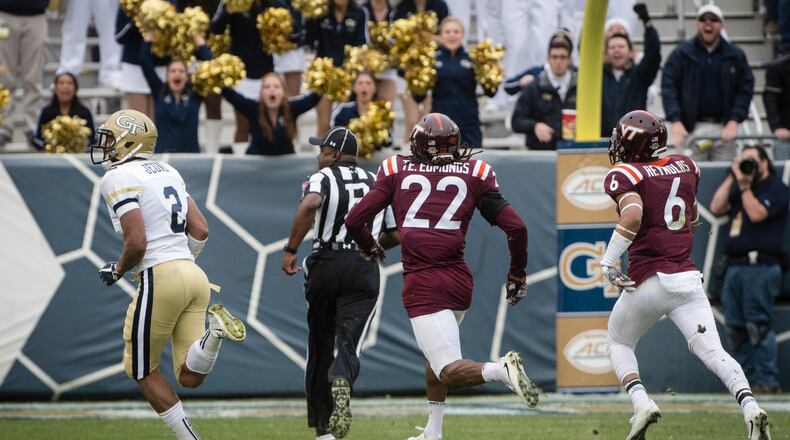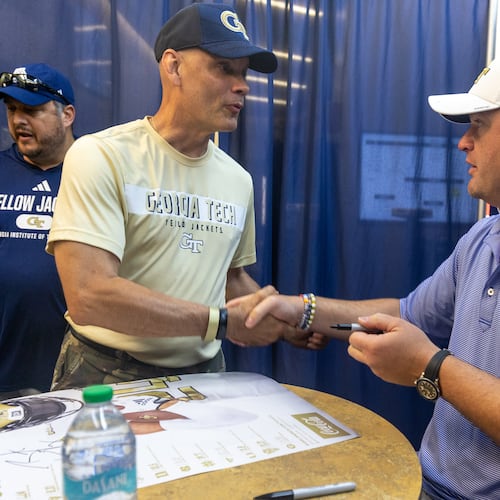In practices leading up to the Virginia Tech game last year, Georgia Tech repeatedly rehearsed a certain play against a particular defensive front that it expected to see from Virginia Tech. In the play, the offense runs what looks like a triple-option play, but an A-back runs against the grain of the play and takes a handoff from the quarterback.
It’s designed to take advantage of a defense aggressively following the motion of a play in the Jackets’ option offense, as the Hokies often do.
Early in the matchup at Bobby Dodd Stadium between the Yellow Jacket and Hokies, coach Paul Johnson sprang the trap.
“That’s always a fun feeling, because usually at that point you know it should open up,” A-back Nathan Cottrell said Saturday, as his team prepared for its game Thursday against Virginia Tech.
It was a handoff from quarterback TaQuon Marshall to Cottrell as he ran right, against the grain of what initially looked like a triple-option play to the left. With the Hokies flowing to their right, the swift Cottrell needed only a lead block from guard Will Bryan to gain the perimeter and race down the east sideline for a 69-yard gain in Tech’s 28-22 upset of the No. 17 Hokies.
“Hopefully we can get some more of that this year, too,” Cottrell said.
Cottrell’s long run was one of three plays of 60 yards or more that Tech pulled off against Virginia Tech defensive coordinator Bud Foster’s unit. It followed two plays of 50-plus yards against the Hokies in Georgia Tech’s 30-20 upset in 2016 at Lane Stadium.
If Georgia Tech is to win a third consecutive game over the Hokies and give its season a reviving jolt, the Jackets will likely require similar big-play assistance. With a young defense, Virginia Tech ranks 95th in total defense and may not be the savvy band that typically shows up to play the Jackets. However, with an open date, Foster has had an extra week to coach up players to play Georgia Tech’s option offense.
“Just like most of the teams you play, it’s going to be hard to drive that ball 80 yards against them four yards a pop,” Johnson said. “Somewhere along the line, you screw up, you miss a read, something happens. So you have to have some explosive plays.”
The five 50-yard plays in the past two meetings were unusual for both the Georgia Tech offense and the Virginia Tech defense. For the Jackets, in their other 14 ACC games in 2016 and 2017, they produced only 13 plays of 50 yards or more. Meanwhile, in the Hokies’ other 14 ACC games, they gave up seven such plays.
“It’s kind of the nature of the way they play,” Johnson said of the Hokies. “They create a lot of negative plays. They blitz a lot, they stunt a lot, they’ve got a lot of guys close to the line of scrimmages. So sometimes when you break ’em, (they can go for long gains). We’ve hit ’em on some big pass plays because they were selling out on the run and some of that.”
Last year, Marshall used a fake toss to help wide receiver Brad Stewart get clear for a 60-yard touchdown reception. Marshall threw the game-winning touchdown pass, an 80-yarder to Ricky Jeune, on another play-action pass. Marshall nearly connected with Jeune off a similar play fake on the first play of the game for what could have been a 75-yard touchdown pass but the throw was long.
Cottrell’s run also took advantage of Virginia Tech’s aggressiveness in pursuing the Jackets’ pre-snap motion. In 2016, the Hokies got burned chasing A-back motion, once on a quarterback follow that Matthew Jordan took 53 yards for a touchdown and later on B-back Marcus Marshall’s 56-yard sprint for a touchdown on a trap play designed to look like an option play to the perimeter.
Such aggressive play is a risk-reward tactic by Foster that has often succeeded. The Hokies were 5-1 against the Jackets in Johnson’s first six seasons (2008-13), though the Jackets have won three of the past four. Take away the two big pass plays and Cottrell’s run from last year’s game, and the Jackets averaged 3.1 yards per play, were tackled for a loss seven times and were 3-for-10 on third down.
The importance for the Jackets to ding the Hokies for big plays may be magnified in this game with their inconsistency on offense and both the punt and kickoff return teams not doing much to produce beneficial field position.
Virginia Tech coach Justin Fuente said that he is “absolutely” mindful of the Jackets’ capacity to hit big plays, acknowledging the vulnerability against the pass because of the stress placed by the run game.
“Everybody talks about the triple option,” Fuente said. “Certainly there’s an element of clock control to it. But when you turn on the film, you realize they have quite a few big, explosive plays either in the running game or throwing the ball down the field.”
About the Author
Keep Reading
The Latest
Featured



